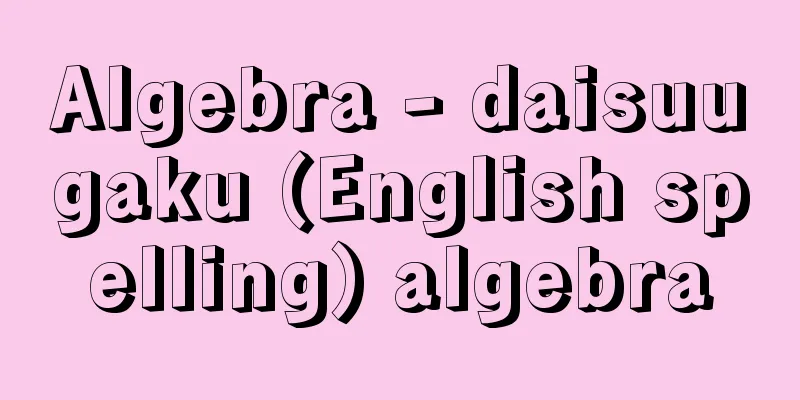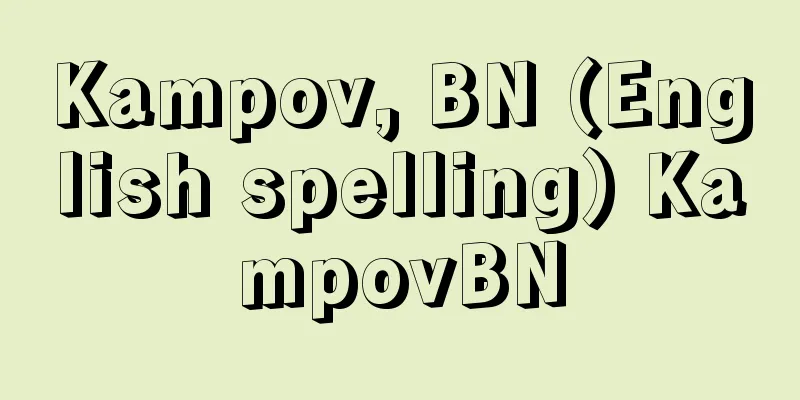Algebra - daisuugaku (English spelling) algebra

|
It is one of the major fields of mathematics along with geometry and analysis, and its main research subject is sets for which operations such as the four arithmetic operations of numbers are defined. More precisely, it is as follows: A×A is the intersection of a set A with itself, and a mapping from A to A f:A×A∋(a,b)→f(a,b)∈A A set for which a finite number of binary operations are defined is called an algebraic system. Modern algebra, simply put, is the study of algebraic systems. Particularly important algebraic systems include groups, rings, fields, and Lie algebras, each of which has its own theory, but research is also being conducted on the relationships between algebraic systems, and applications to other fields of mathematics are also being considered. [Tsuneo Kanno] Group Theory In the set Z of all integers, two binary operations, addition and subtraction, are possible. On the other hand, in the set Q x of all rational numbers other than 0, multiplication and division are possible. These two algebraic systems Z and Q x are different sets, and their binary operations are completely different, but they share a common property. This is the idea of a group. In other words, if there is a set G where f:G×G∋(a,b)→f(a,b)∈G Now, if we define groups in this way, we can see that there are groups other than groups of numbers such as Z, Q, and x . For example, let M be a nonempty set, and P(M) be the set of one-to-one mappings from M onto M. For elements σ and μ of P(M), Also, when M is a linear space, the set GL(M) of all linear mappings of elements σ of P(M) is itself a group. If the dimension of the linear space is n, then this group GL(M) is essentially the same as the multiplicative group of all n-th order square matrices whose determinant is not zero, and is called the automorphism group of the linear space M. Group theory is the study of groups, especially f(a,b)=f(b,a) (a,b∈G). [Tsuneo Kanno] Ring theoryThe set of integers Z can be multiplied as well as added and subtracted. In this way, the set A becomes a commutative group because (5) A×A∋(a,b)→a+b∈A. (6) For A×A∋(a,b)→ab∈A,
[Tsuneo Kanno] Theory of matterThe set of rational numbers Q is a commutative ring, since addition, subtraction, and multiplication are possible, but it can also be divided by elements other than 0. Thus, the set K is (10)K is a commutative ring under addition and multiplication. (11) Every non-zero element K x of K is a group under multiplication. If this holds, then K is called a field. Like Q, the set of real numbers R and the set of complex numbers C are fields, but Z is a ring that is not a field. A field is a special type of ring, and is commonly referred to as an algebraic system in which the four arithmetic operations are possible. However, one of the four arithmetic operations, division, (a,b) → ab -1 , is possible when b ≠ 0, so strictly speaking it is not a binary operation of K. When K x becomes a commutative group in condition (11), K is called a commutative field. A field that is not a commutative field is called a non-commutative field, and a commutative field is sometimes simply called a field. Q is the smallest field contained in C, but there are an infinite number of fields between Q and C. Such a field is called a number field. According to the Fundamental Theorem of Algebra, for a Q coefficient n ≧ degree polynomial f(X), if the highest degree coefficient is 1, then Now, the smallest field Q(ω 1 ,……,ω n ) containing the roots ω 1 ,……,ω n of f(X) in (12) and Q consists of all the numbers that can be obtained from the n numbers ω 1 ,……,ω n and elements of Q by a finite number of arithmetic operations. If we consider the field Q(ω 1 ,……,ω n ) as a set and use a substitution σ, then for elements a and b of Q(ω 1 ,……,ω n ), σ(a+b)=σ(a)+σ(b), A number that is not an algebraic number is called a transcendental number. If a number field K contains a transcendental number, then K is said to be a transcendental extension field of Q. Fields of this kind appear as function fields on algebraic varieties and are important in algebraic geometry. [Tsuneo Kanno] Lie algebra The axiom (5) of rings holds, and furthermore, instead of (6), we have a kind of multiplication (a,b) → [a,b] The set of n-th order square matrices Mn(C) is a ring through matrix addition and multiplication, but it is also a Lie algebra through matrix addition and the new multiplication [a,b] = ab-ba. There is a concept called a Lie group that combines groups and manifolds, and the tangent space of this group at the identity element becomes a Lie algebra in a natural way. In this way, Lie algebras are linked to manifolds and are important. [Tsuneo Kanno] History of AlgebraIf the expression of numbers with symbols is the beginning of algebra, it was practiced in India, Arabia, Egypt and other places before Christ. Notation was perfected in Europe in the 16th century, and following the linear and quadratic equations that had already been found, Cardano discovered solutions to cubic equations and Ferrari discovered solutions to quartic equations. After that, research was conducted on algebraic solutions to equations of degree five or higher, but in the 19th century, Abel, Galois and others proved that algebraic equations of degree five or higher cannot generally be solved algebraically. The basis for this is the so-called Galois theory. The reorganization of this theory and research such as Fermat's problem served as a catalyst for the establishment of the basic theory of groups, rings and fields. In addition, algebraic theory was applied to geometry and analysis, such as proving old geometric problems such as angle trisection, while various algebraic systems using axioms were devised, leading to the creation of today's abstract algebra. [Tsuneo Kanno] "Algebra" edited by Masayoshi Iyanaga and Masami Nunokawa (1968, Iwanami Shoten)" ▽ "Introduction to Algebra" by Makoto Ishida (1978, Jikkyo Publishing) [Reference] | |Source: Shogakukan Encyclopedia Nipponica About Encyclopedia Nipponica Information | Legend |
|
幾何学、解析学と並ぶ数学の大きな分野の一つで、数の四則のような演算が定義された集合をおもな研究対象にしている。より正確にいえば次のようになる。集合AとA自身との積集合A×AからAへの写像 有限個の二項演算が定義されている集合を代数系という。現代の代数学は、ひとことでいえば、代数系を研究する数学である。とくに重要な代数系として、群、環、体、リー環があり、それぞれに独自の理論ができているが、相互の代数系を関係づけた研究もなされ、また、他の数学の分野への応用も考えられてきている。 [菅野恒雄] 群論整数全体の集合Zでは、数の足し算と引き算の二つの二項演算ができる。一方0以外の有理数全体の集合Qxでは、数の掛け算と割り算ができる。これら二つの代数系Z、Qxは集合としても違うし、その二項演算もまったく異なるが共通の性質をもっている。それが群という考え方である。つまり、集合Gに さて、群をこのように定義すると、Z、Qxのような数の群以外の群があることがわかる。たとえば、Mを空でない集合とし、P(M)をMからMの上への一対一写像全体とする。P(M)の元σ、μに対し、 また、Mが線形空間のとき、P(M)の元σで線形写像になっているもの全体の集合GL(M)は、それ自身、群になる。この群GL(M)は、線形空間の次元をnとすると、n次正方行列で行列式が0でないもの全体のつくる乗法群と本質的に同じで、線形空間Mの自己同形群という。 群を研究する数学が群論であるが、とくに [菅野恒雄] 環論整数全体Zは、足し算、引き算のほかに掛け算もできる。このように集合Aが (6)A×A∋(a,b)→ab∈Aについて、
[菅野恒雄] 体論有理数全体Qは、足し算、引き算、掛け算ができて、可換環であるが、さらに0以外の元による割り算ができる。このように集合Kが (11)Kの0以外の元全体Kxは乗法で群である。を満たすとき、Kを体という。 Qと同様に、実数全体R、複素数全体Cは体であるが、Zは体でない環である。体は、環の特別なもので、俗に、四則演算が可能な代数系といわれるが、四則のうちの割り算、(a,b)→ab-1はb≠0のとき可能であるから、厳密にいうとKの二項演算ではない。条件(11)でKxが可換群になるとき、Kを可換体という。可換体でない体を非可換体といい、可換体を単に体ということもある。QはCに含まれる最小の体であるが、QとCの間に無数の体がある。このような体を数体という。 Q係数のn≧一次多項式f(X)は、代数学の基本定理により、最高次の係数を1とすると、 さて、(12)のf(X)の根ω1、……、ωnとQを含む最小の体Q(ω1,……,ωn)は、n個の数ω1、……、ωnとQの元から有限回の四則演算で得られる数全体からなるが、体Q(ω1,……,ωn)を集合と考えての置換σでQ(ω1,……,ωn)の元a、bに対し 代数的数でない数を超越数という。数体Kが超越数を含むとき、KをQの超越拡大体という。この種の体は、代数多様体の関数体として現れ、代数幾何学で重要である。 [菅野恒雄] リー環環の公理(5)が成り立ち、さらに(6)のかわりに一種の乗法(a,b)→[a,b]について n次正方行列全体Mn(C)は、行列の加法と乗法で環であったが、行列の加法と、新しい乗法[a,b]=ab-baでリー環にもなっている。群と多様体の結合概念にリー群といわれるものがあるが、この群の単位元での接空間は自然な方法でリー環になる。このように、リー環は多様体と結び付き、重要である。 [菅野恒雄] 代数学の歴史数を記号で表すことが代数学の始まりなら、それは紀元前インド、アラビア、エジプトなどで行われていた。16世紀ヨーロッパで記号法が完成し、すでに得られていた一次方程式、二次方程式に次いで、カルダーノの三次方程式、フェラリの四次方程式の解法の発見がある。その後、五次以上の方程式の代数的解法の研究がなされたが、19世紀に入り、アーベル、ガロアらによって、次数が五以上の代数方程式は一般には代数的に解けないことが証明された。この根拠に、いわゆるガロアの理論がある。この理論の整理とフェルマーの問題などの研究が契機となり、群、環、体の基礎理論が確立された。 また、角の三等分など、古い幾何学の問題が代数の理論で証明されるなど、幾何学、解析学に応用される一方、公理を用いたさまざまな代数系が考え出され、今日の抽象代数学ができあがった。 [菅野恒雄] 『彌永昌吉・布川正巳編『代数学』(1968・岩波書店)』▽『石田信著『代数学入門』(1978・実教出版)』 [参照項目] | |出典 小学館 日本大百科全書(ニッポニカ)日本大百科全書(ニッポニカ)について 情報 | 凡例 |
Recommend
Wilcox, HH - Wilcox
...A district of Los Angeles located approximatel...
Eid (Esperanto) - Eid
…However, contrary to the ideals of its creator, ...
Otome Aoi - Otome Aoi
...Its distribution is wide and polymorphic, but ...
Sautrāntika (English spelling)
Also called the Sutra school. A sect of Indian Bud...
Nicolet, A.
…In each category, the top two prizewinners are a...
Cebu [island] - Cebu
A long, narrow island stretching from north to sou...
Masaharu Inoue
1806-1847 A daimyo in the late Edo period. Born o...
Japan Travel Journal - Nihonhoshoshi
A bibliographical work written by Yang Shoujin of ...
Ulva conglobata (English spelling) Ulvaconglobata
…[Mitsuo Chihara]. . . *Some of the terminology t...
Nāṣīf al‐Yāzijī
1800‐71 A Christian who represents the first gener...
Geometric style
A term of art. A style of decorative pattern. Gen...
Waterboar - Waterboar
...From the first president JH Hoffman (in office...
Awaseguchikamekan - Awaseguchikamekan
A coffin used in northern Kyushu during the Yayoi ...
Augsburg Chronicles
…A chronicler from Augsburg, southern Germany. So...
Flycatcher
…General term for birds of the passerine order Ty...







![Shimoji [town] - Shimoji](/upload/images/67cbcb592ffe1.webp)
![Ajigasawa [town] - Ajigasawa](/upload/images/67cad37e59076.webp)
